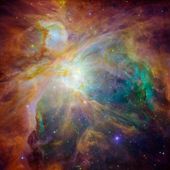Piffle, suggests one astrophysicist, at least when it comes to explaining what force could have permanently bent a ring in our Milky Way Galaxy within the last 60 million years. The real explanation may be the power of an invisible wrecking ball made of dark matter - a cloud of the enigmatic physics particles born in the fiery aftermath of the Big Bang and weighing as much as 10 million suns.

In the study, Bekki offered a new explanation for the Gould Belt, which 19th-Century astronomers first noted. It circles more than 3,000 light years outside the center of the Milky Way (where a light year equals 5.9 trillion miles) at a 20-degree tilt from the galaxy's rotating spiral arms. In 1997, the astronomer W. G. L. Poppel pointed out that astronomers could not explain where all its young stars, perhaps 2 million of them less than 60 million years old, came from using common explanations of star formation.
"The point is that the sun is immersed in the Gould Belt," Poppel added, suggesting we might want to know how all these young stars came to surround our 4.6 billion-year-old sun.
Since then, Bekki notes, researchers such as Juerg Diemand at the University of California, Santa Cruz, have reported hundreds of dense dark matter clouds that may zoom near the sun's neighborhood of the galaxy.
So what is dark matter? Astronomers have only detected it by its gravitational pull on galaxies; it is literally dark, which makes it impossible to see with telescopes and leads them to believe that so-called "weakly-interacting massive particles" (WIMPS, in a bit of physics humor) - exotic physics particles much like neutrinos that only rarely electromagnetically interact with normal atoms - comprise the bulk of the stuff. Most likely, dark matter was cooked up and clumped together in the primordial chemistry of the Big Bang some 13.7 billion years ago. Despite its darkness, the gravitational tug of dark matter suggests there is about five times more of it than normal matter, the stuff of stars, planets and people, in the universe.
"In the new scenario presented in the (study), the Gould Belt is one of the stellar substructures formed from high-speed, off-centre collisions between giant molecular clouds, which are believed to be the birth place for stars and dark matter clumps orbiting the Galaxy," Bekki writes. Using computer models to test a collision between a dark matter clump and a hydrogen gas cloud merely 1 million times heavier than the sun, he finds that within 45 million years the dark matter's gravity would have indeed spawned a tilted ring of infant stars looking much like the Gould Belt.
"This is a very promising result," says astrophysicist Varoujan Gorjian of NASA's Jet Propulsion Laboratory in Pasadena, Calif. "The Gould's Belt result gives a new tool to try to see if our idea of how dark matter may be distributed in a galaxy is correct," he adds, "since we can't actually observe dark matter itself we need to see the secondary effect that those clumps may have. The Gould's Belt model makes a good case that in fact dark matter may reside in clumps."
And what about those comets from the distant Kuiper comet belt beyond Pluto hurtling toward Earth? The study shows the distance between the sun and the massive dark matter cannonball could have been as close as 326 light years away, Bekki says by e-mail, so that the gravitational force of the Dark Matter Clump can be stronger than that of the sun in the very outer part of the solar system. The Kuiper belt would be significantly perturbed owing to this. As a result of this, a lot of comets would intrude into the inner part of the solar system (possibly to the Earth) after the dark impact.
Take that, Chuck Norris. Just imagine the sky lighting up with new stars more than 30 million years ago. "This is pure speculation," Bekki adds. But if the Milky Way has 20 dark matter clumps hanging around, he reckons that a Gould Belt-like star ring likely forms from dark matter collisions every billion years or so. And about 0.1% of hundreds of billions of stars in our galaxy started this way.
Concludes the paper: "The Gould Belt is not just a magnificent stripe of stars in the night sky but also a fossil record containing profound physical meanings of a dramatic event which would have happened in the solar neighborhood."



Reader Comments
to our Newsletter